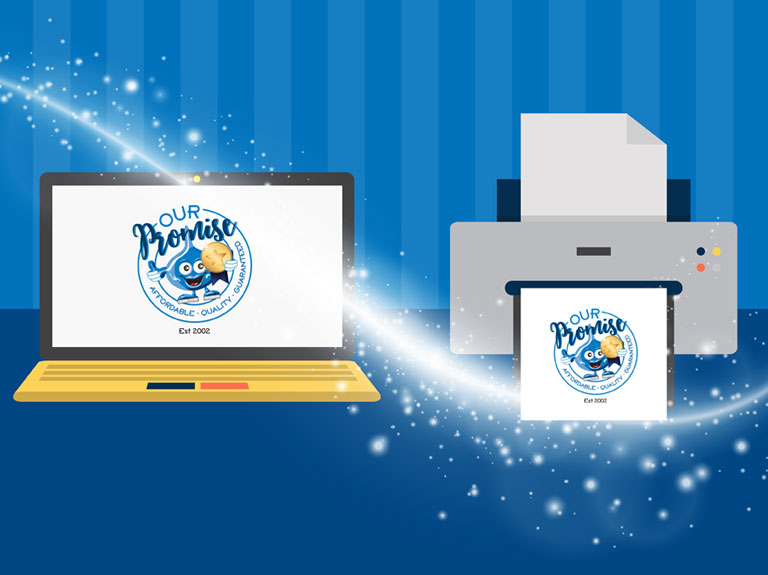
The anatomy of an inkjet/laser printer: How the magic happens
A printer. A black or grey or white box-shaped mechanical object. It takes ideas that exist in a virtual space where we can’t touch them, and magically brings them to life, on paper. Let's look at what takes place after you hit print, to make the magic happen.
Disclaimer: This blog is best suited to tech junkies and folk who like to know 'how-things-work'.

Anatomy of a laser printer
Laser printers work in a similar way to photocopiers, using light. The light reflects off a page and onto a light-sensitive drum. Ink is then transferred to the page, copying the image that is reflected by using static electricity to get the ink to conform to the correct shapes. In the case of a photocopy machine, the machine simply needs to replicate a document that already exists. Laser printers, however, have to create the image from a virtual space.
Step one: Make magic with a laser printer
When you command your laser printer to create solid colour from virtual data, you’re making tech magic happen. “Each piece of data is stored electronically by a microscopically small switching device called a transistor. The printer's job is to convert this electronic data back into words and pictures: in effect, to turn electricity into ink.”
Step two: The electronic circuit interprets your desires
The electronic circuit receives the instructions telling it what to print. Essentially, the circuit is like a small computer that can store virtual data and command it into reality. When the circuit comes to life, it alerts the corona wire. The corona wire sends static electricity to the photoreceptor drum.
Step three: Hello laser printer
The laser wakes up at the same time. The laser beam remains stationary, bouncing off a moving mirror to deliver ink evenly across the page as needed. It does this because the laser beam hits the drum. When it hits the drum, it removes the positive charge that was there, replacing it with a negative charge. Eventually, it creates a copy of the entire image on the drum, areas that were white would have colour.
Step four: Enter ink
The ink rollers contain powdered toner particles that have a positive charge. Their positive charge means they adhere to the zones with a negative charge, creating the image. This means, the parts of the drum that have a positive charge receive no ink - they remain white.
Step five: The positive paper
The paper is passed through the rollers. It is given a positive charge, so the ink particles adhere to it. The image is “printed” by moving it from the drum onto the page. The two rollers use heat and pressure to force the ink particles to adhere to the paper.
Anatomy of an inkjet bubble printer
Inkjet printers are known for their affordability. They often come with a combination of features, offering basic photocopying, scanning, and printing facilities in one convenient device. Here’s how it all fits together and takes your imagined, drawn, designed or written document from a virtual concept to a concrete print out.
Step one: The nozzles plan their moves
Inkjet printers create each colour using microscopic nozzles. Each one is roughly 1/10th of a human hair in diameter - tiny! Each colour has thousands of nozzles dedicated to it, each nozzle ejects a small round dot of ink onto the paper. Once you have enough dots in the shape you need them to be, you have your shape. A moving carriage assembly ensures the dots are delivered according to the image.
Step two: Lights, camera, colour!
When you hit the “print” button on your computer, it activates the electronic circuit. The electronic circuit instructs the nozzles via a resistor, where and how to place their ink. The process is incredibly accurate but fast.
Step three: The resistor
The resistor is charged with electricity to heat it up. The warmth causes the ink to boil and bubble. As the ink boils, hot bubbles of colour are formed which eventually burst, ejecting the ink onto the page. The ink is delivered with precision into its specified dot on the page.
Step four: Bubbles and vacuums
When the bubble pops, it creates a partial vacuum inside the nozzle which allows more ink to be drawn up and the whole process is repeated. This intricate process takes place at great speed. From the outside, you can hear the carriageway move back and forth.
A printer is one of those everyday objects that make life simpler and more productive, as it takes your ideas from your desktop into your hands!
Get the most value out of your printer with The Inky Shop printer consumables which are big on quality and little on price.
With an easy-to-use online store and convenient delivery to your door, there’s no better way to stock up on those printer consumables. To get started, please click here: https://inkyshop.co.za/collections/all
Should you still wish to pop in to your closest Inky Shop, please use our store locator to find yours now: https://inkyshop.co.za/pages/store-locator Rest assured that our staff are following strict hygiene protocols for your safety and theirs.
Don’t forget to follow us on our social media accounts for more tips and special offers:
